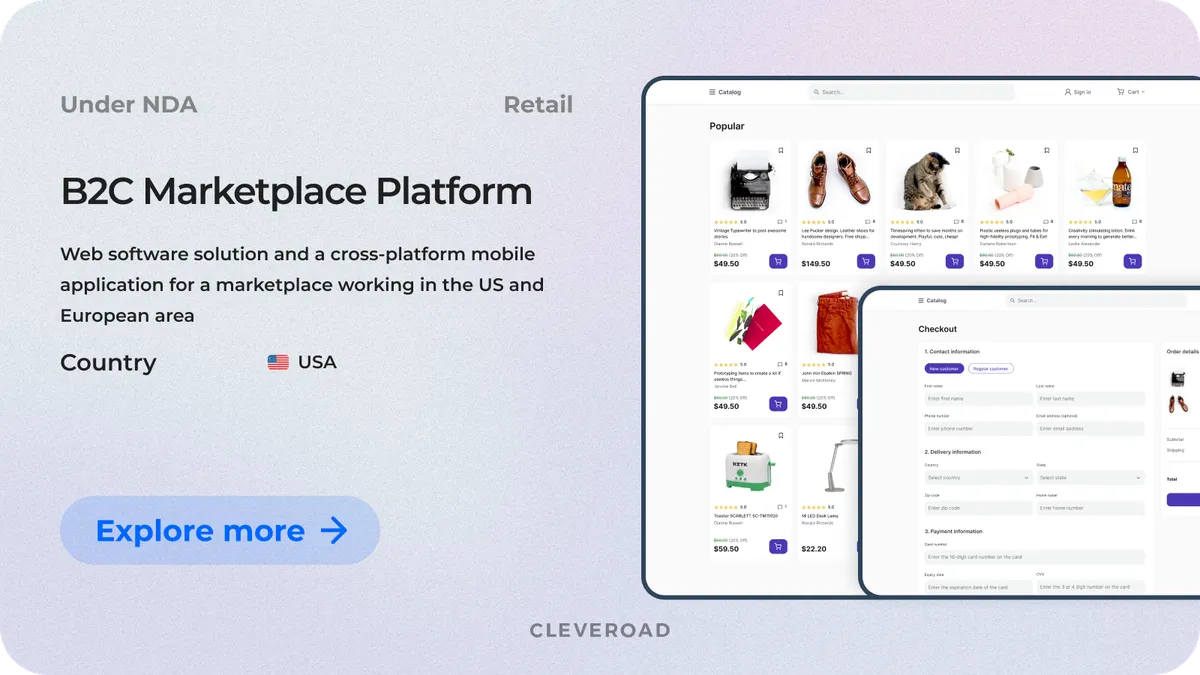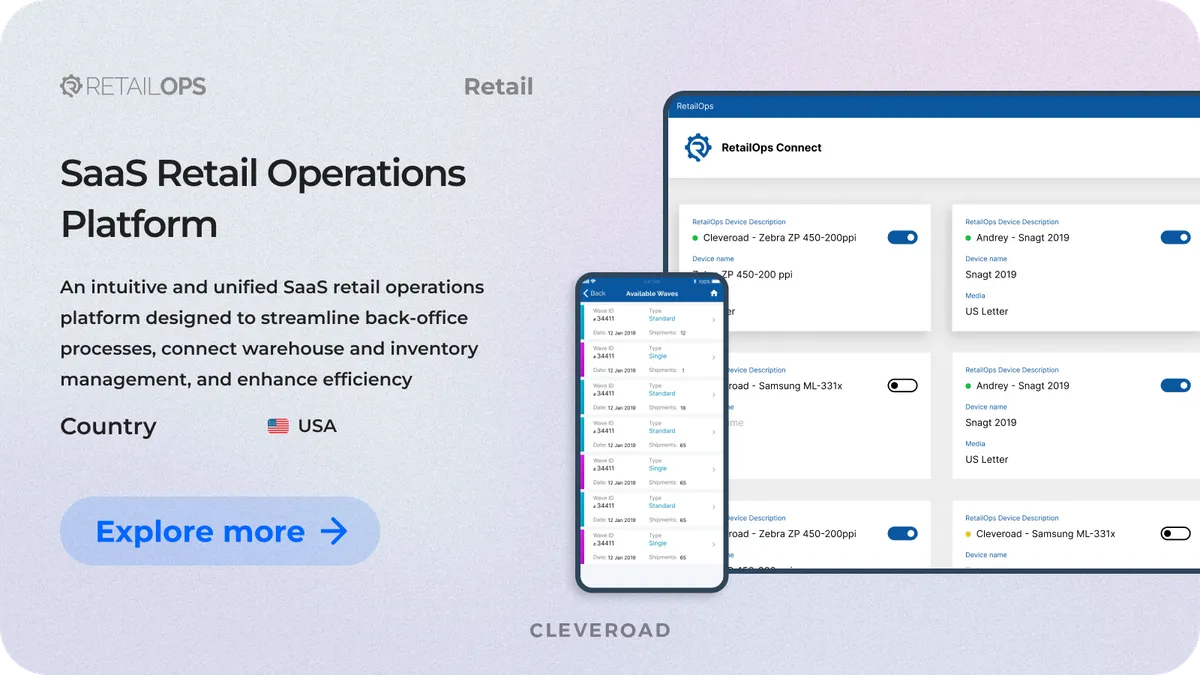AI in Retail: 10 Use Cases You Should Know
28 Oct 2025
19 Min
148 Views
Think about the potential of Artificial Intelligence (AI) for modern stores today. Prices adjust in real time, product recommendations follow your behavior, and even inventory decisions happen long before you realize a trend is forming. That’s the reality of the AI-driven retail industry.
At Cleveroad, we have experience in integrating AI in retail platforms, so we have seen industry transformation shift firsthand. Over the past few years, more and more of our retail clients have asked us to implement AI features such as demand forecasting and personalized recommendations, as well as customer analytics and fraud detection.
Since 2021, our team of AI integrators and data experts has helped retailers of all sizes integrate AI into their operations. Based on this experience and insights from our in-house AI integration team, we created this practical guide to AI in retail business, where you’ll learn:
- What AI in retail is and how it works
- The main benefits and use cases of AI in retail
- How leading brands use AI to improve operations
- Steps to implement AI in your retail business
- Key challenges and how to overcome them
- What the future of AI in the retail industry looks like
What Is Artificial Intelligence and Why Is It Important for Retail?
Artificial intelligence is a broad term that refers to computer systems capable of performing tasks that typically require human intelligence. AI is a collection of computer-science technologies that allow machines to perform tasks that normally require human intelligence. These include:
- Machine learning (ML). Algorithms that learn from data over time and improve their predictions without being explicitly programmed.
- Predictive analytics. Statistical models and ML systems that forecast future outcomes (e.g., demand, customer behavior) based on historical and real-time data.
- Natural language processing (NLP). Tools that let computers understand, interpret, and generate human language (for chatbots, virtual assistants, etc.).
- Computer vision and IoT-driven analytics. Sensors, cameras, and Internet-of-Things (IoT) devices feed vast volumes of data into AI systems, which then extract actionable insights.
The role and benefits of AI in retail business
When applied to retail, AI systems analyze vast amounts of data, from sales transactions and customer profiles to sensor readings and market trends, to improve every stage of the value chain. They process this information to predict demand, personalize experiences, and automate decisions that make operations faster and more efficient. Advanced algorithms can even act autonomously, transforming data from eCommerce analytics into real-time insights that guide smarter business actions.
In essence, artificial intelligence in retail helps companies anticipate customer needs, personalize communication, and optimize everything from pricing to post-purchase engagement. By turning data into actionable intelligence, AI enables retailers to operate more efficiently, make informed decisions, and create meaningful, data-driven customer experiences.
Here are the key areas where AI in retail business delivers the most value:
Personalized customer experience
AI systems for retail analyze customer behavior, purchase history, and preferences to provide personalized recommendations and targeted promotions. McKinsey studies reflect that 80% of consumers will purchase from companies that offer personalized experiences.
Accurate demand forecasting and inventory management
Predictive analytics enable retailers to anticipate demand fluctuations and avoid stockouts. By analyzing historical sales data and market trends, AI systems help maintain optimal inventory levels and improve the efficiency of the supply chain.
Operational automation and cost efficiency
In supply chain logistics and checkout automation, AI optimizes repetitive tasks and lowers operational costs. According to McKinsey, retailers boost their revenue by 5–10% and cut operational costs by 20–30% using predictive analytics.
Fraud detection and risk management
AI retail applications can detect unusual transaction patterns, helping prevent fraud and loss. They continuously learn from new data to identify suspicious behavior faster and more accurately, protecting retailers from chargebacks, refund abuse, and internal theft.
Smarter decision-making and strategic insights
By combining AI and advanced analytics, retail companies can make faster decisions across pricing and marketing. AI-powered decision support systems can deliver up to a 5% increase in retail sales while raising EBIT margins by 0.2–0.4 percentage points (Source: McKinsey).
Use our AI development services to implement cutting-edge intelligent technologies and take your retail business to the next level of growth
Use Cases of Artificial Intelligence in Retail Industry
The AI in retail industry is evolving fast, moving beyond experimentation toward end-to-end automation and decision intelligence. Today, AI retail solutions address real operational pain points. They detect trends, optimize prices, predict demand, and personalize experiences with precision that traditional systems can’t match. So, we’ve prepared the best use cases to explain how AI technologies solve specific retail challenges.
Personalized customer experience
Retailers often struggle to tailor interactions at scale, resulting in generic recommendations and poor conversion rates. AI in retail business changes this by unifying customer and behavioral data across online and offline channels. Machine learning models analyze browsing patterns, purchase histories, and contextual signals in real time to deliver personalized product suggestions and promotions.
Under the hood, personalization systems rely on deep learning architectures that capture sequential and contextual relationships, such as GRU-based or Transformer-based recommendation engines. Retrieval-ranking pipelines powered by vector embeddings ensure relevant items appear instantly, while contextual bandit models continuously test and optimize recommendations.
Improved cross-selling opportunities
Traditional cross-selling depends on rigid business rules and predefined associations between products. AI applications in retail industry enhance this process by dynamically analyzing cart compositions and customer intent to suggest complementary products at the right moment.
AI software often implements graph neural networks that model relationships between customers and items, learning which combinations drive higher-order values. Coupled with sequence prediction models and pairwise ranking frameworks, they identify the most effective next-best offers while respecting margin and inventory constraints through optimization layers.
Automated inventory management
Manual shelf audits and outdated ERP inputs lead to inaccurate stock levels and missed sales. AI in retail operations solves this by combining vision systems and IoT sensors to detect stockouts, misplaced items, or planogram deviations automatically. Edge-based computer vision models capture product facings and trigger replenishment tasks in real time.
Automated inventory management systems use object-detection and segmentation networks such as YOLO or Detectron to recognize SKUs, along with multi-object tracking algorithms to monitor item movement across camera feeds. Combined with optical character recognition and edge inference frameworks, they maintain inventory accuracy without human intervention.
Demand forecasting
Static forecasting models often fail to capture changing market dynamics, seasonality, and promotions. Artificial intelligence in retail industry applies predictive analytics to anticipate demand with higher accuracy by analyzing sales, weather, event calendars, and supply signals simultaneously.
Modern forecasting engines rely on probabilistic time-series models like DeepAR or Temporal Fusion Transformer, which generate predictions with uncertainty ranges. Gradient-boosting ensembles such as LightGBM handle structured retail data, while hierarchical reconciliation techniques align forecasts across product categories and store networks.
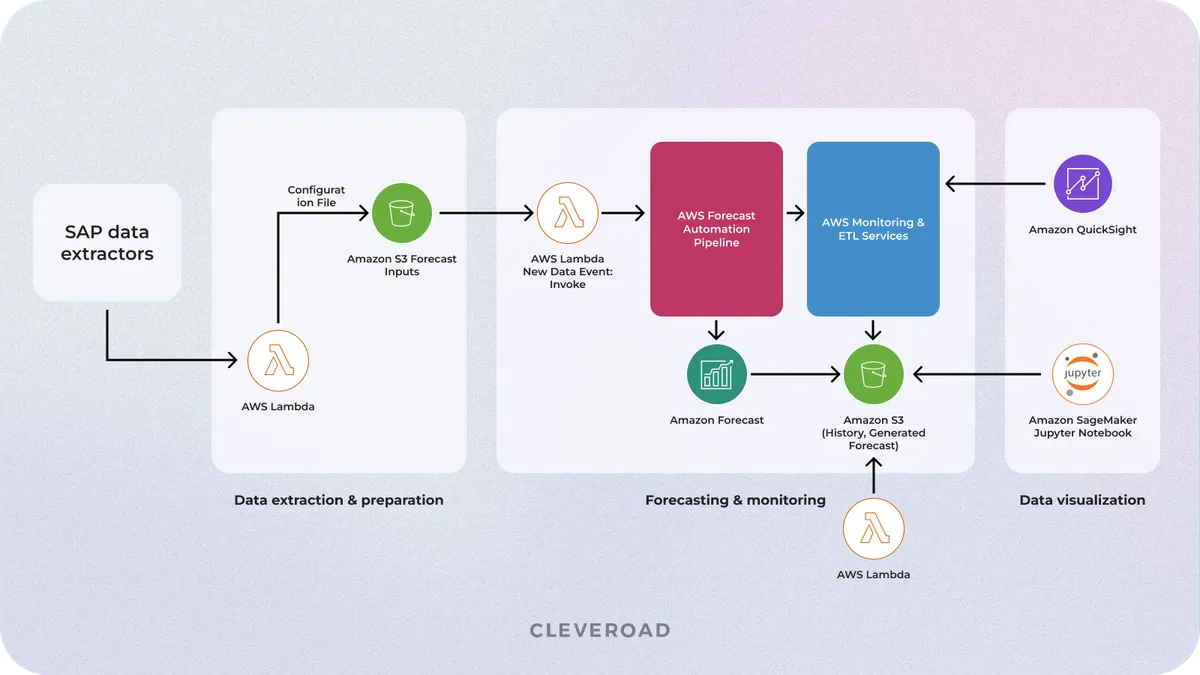
AI retail solution reference architecture
Frictionless shopping
Checkout friction remains a major cause of cart abandonment. AI retail technologies enable a fully autonomous shopping and retail experience, where computer vision and sensor fusion identify products as shoppers take them, allowing retailers to provide instant payment and exit.
Frictionless shopping relies on multi-camera person re-identification models and object interaction detection to track shoppers and items simultaneously. Embedding-based similarity search recognizes products by appearance, and Bayesian data-fusion techniques combine video and sensor input to achieve near-perfect accuracy in real time.
Optimized pricing
Retailers lose margin when pricing models can’t react to competitive changes or demand shifts. AI in retail analytics automates this process by continuously analyzing demand elasticity, competitor prices, and sales performance to suggest optimal price adjustments.
Pricing systems often combine reinforcement-learning agents that learn sequential price strategies with causal-inference models that estimate the true impact of promotions. These are wrapped in constraint-optimization layers to maintain compliance with price floors, ceilings, and profitability rules.
Dynamic merchandising
Static merchandising layouts can’t reflect real-time shopper intent or inventory levels. AI for retail business uses behavioral and contextual data to dynamically reorder product listings, digital shelves, and in-store displays for maximum engagement.
The dynamic merchandising process depends on learning-to-rank algorithms trained on search intent data, integrated with constraint solvers that account for shelf space and adjacency. Counterfactual evaluation methods validate merchandising changes safely without the need for full A/B rollout.
In-store robots
Store audits, safety checks, and shelf inspections consume thousands of labor hours monthly. AI retail solutions use autonomous robots equipped with vision and mapping technologies to monitor aisles and detect irregularities.
In-store robots leverage simultaneous localization and mapping (SLAM) for navigation, object-recognition networks for compliance tracking, and unsupervised anomaly-detection models to identify hazards or misplaced items. Continuous learning pipelines allow robots to adapt to new packaging and store layouts over time.
Smart stores
Disconnected systems prevent retailers from reacting to in-store events in real time. AI technology in retail enables smart-store ecosystems that connect POS systems, sensors, cameras, and workforce tools through a single data layer.
Smart stores’ foundation is a digital-twin architecture that mirrors every physical store in a virtual environment. Complex event-processing frameworks analyze activity streams to trigger automated actions, such as adjusting lighting and promotions or optimizing staff allocation, all powered by edge computing for ultra-low latency.
Supply chain optimization
Unpredictable lead times and inefficient routing reduce service levels across retail networks. Artificial intelligence for retail integrates forecasting, logistics, and procurement data to optimize the entire supply chain in real time.
Supply chain optimization systems employ graph neural networks to map and predict disruptions across distribution nodes, stochastic optimization models for inventory allocation, and causal-inference analytics to separate demand signals from promotion effects. Together, they improve on-time delivery, reduce logistics costs, and strengthen resilience across the retail ecosystem.
Technologies Behind Artificial Intelligence Solutions for Retail
So far, we’ve discussed what AI in retail business is and how it improves forecasting, personalization, and operations. Let’s now go deeper into the technologies that make these results possible.
Artificial intelligence in retail depends on a complex ecosystem of interconnected tools like data management systems or advanced machine learning models. Each of these technologies powers a different part of the retail value chain and works best when integrated into a unified digital infrastructure. Below are the core technologies behind AI for retail.
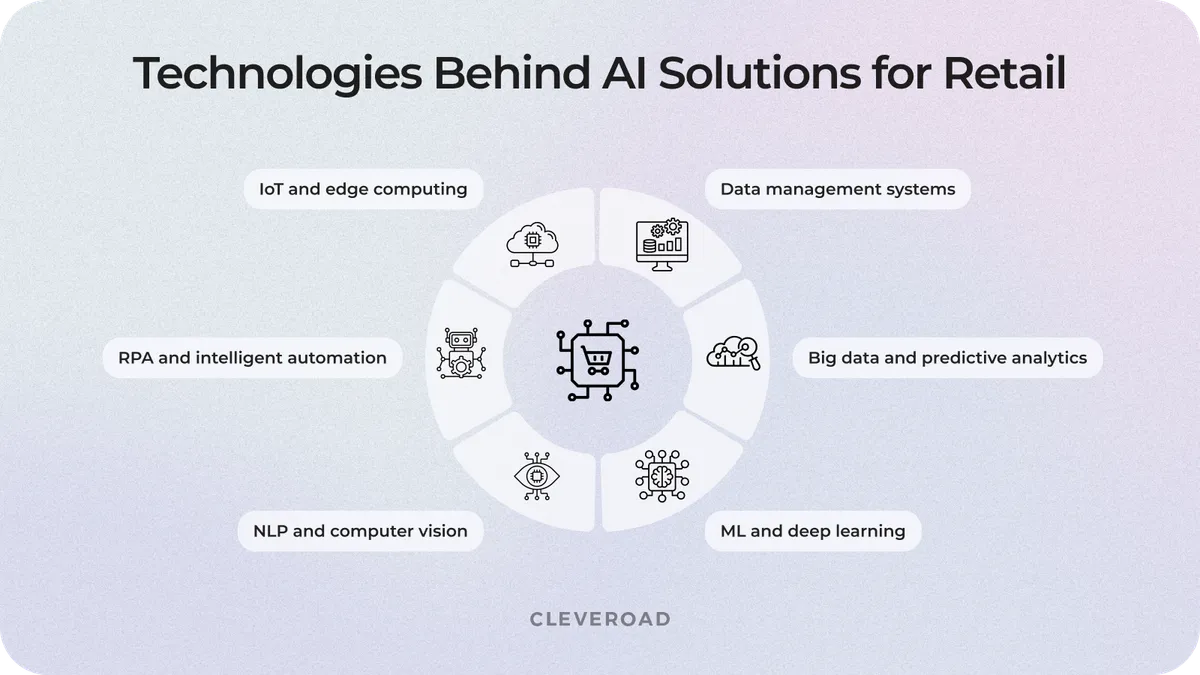
Technologies behind AI solutions for retail
Data management and integration systems
Every AI solution for retail starts with data. Retailers generate massive volumes of data every day, such as sales, product catalogs, customer interactions, logistics updates, and marketing performance. To make sense of it, they need robust data management systems. These include:
- Data warehouses, data lakes, and data lakehouses. Centralized repositories that collect and store data from various sources, such as sales, customer interactions, and supply chain systems. They organize structured and unstructured data, making it easier for retailers to analyze purchasing trends, optimize operations, and feed clean data into AI in retail industry models.
- Data integration tools. Systems that extract, transform, and load (ETL) data from multiple sources into unified storage. These tools ensure data consistency and accuracy by removing duplicates, standardizing formats, and validating inputs before the data is used for AI retail solutions like forecasting or personalization.
- Cloud data platforms. Scalable environments that provide the infrastructure for storing, processing, and analyzing large datasets in real time. They enable AI for retail businesses to access information instantly, run predictive models at scale, and support advanced analytics across multiple channels with improved speed, flexibility, and cost efficiency.
Big data and predictive analytics
The AI in retail industry depends on data-driven predictions. Big data and predictive analytics processes vast datasets to identify trends and guide real-time decisions. These tools turn raw information into business intelligence by spotting correlations humans might overlook.
They work by combining data mining, statistical modeling, and machine learning algorithms to analyze both historical and real-time data streams. Predictive systems evaluate variables such as sales history, customer demographics, pricing elasticity, and seasonal demand to forecast future outcomes with high precision. In practice, these technologies enable AI retail analytics tools to anticipate product demand, optimize pricing strategies, detect anomalies, and personalize marketing campaigns, all while continuously improving through feedback and new data inputs.
Machine learning (ML) and deep learning
ML is the engine of artificial intelligence in retail industry. Machine learning in retail allows systems to learn from data and improve their accuracy over time. Retailers apply AI and machine learning to automate decisions, reduce manual errors, and continuously adapt to new market conditions.
Machine learning works by training algorithms on large volumes of historical and real-time data to identify patterns, relationships, and dependencies within it. The model uses this knowledge to make predictions or automate decisions without being explicitly programmed for each task. In AI retail applications, machine learning models are trained on datasets such as sales transactions, customer behavior, inventory levels, and pricing trends. Over time, they refine their accuracy by comparing predicted results with actual outcomes, learning from errors, and adjusting parameters automatically. This continuous learning process allows retailers to make data-driven business decisions.
Natural Language Processing (NLP) and computer vision
Two of the most visible technologies in AI retail applications are natural language processing and computer vision.
Natural Language Processing (NLP) helps machines understand, interpret, and generate human language by combining linguistics, machine learning, and deep learning models. NLP processes text or speech through several steps:
- Tokenization (splitting text into smaller units)
- Part-of-speech tagging
- Semantic analysis, to extract meaning and intent
Modern NLP systems rely on large language models (LLMs) like Transformer-based architectures, which analyze massive datasets of human communication to understand context, tone, and sentiment. In retail, these models power chatbots, virtual assistants, and sentiment analysis tools, allowing them to interpret customer questions, detect emotions, and generate relevant, human-like responses.
Computer vision enables machines to interpret and understand visual data such as images or videos. It uses Convolutional Neural Networks (CNNs) and object detection algorithms (like YOLO or Faster R-CNN) that scan visual inputs pixel by pixel, detect shapes and colors, and recognize objects or patterns within the frame. The system learns by training on labeled datasets, for instance, thousands of product or shelf images, to identify what each object looks like. In AI retail solutions, computer vision is applied for inventory tracking, visual search, automated checkout, and planogram compliance, recognizing products, detecting stock levels, and monitoring customer behavior in real time.
When combined, NLP and computer vision improve the AI shopping experience, creating smarter, faster, and more intuitive interactions between customers and brands.
Generative artificial intelligence
Generative AI works by using deep learning architectures, primarily transformer-based neural networks, trained on massive datasets containing text or other types of content. During training, the model learns the structure, patterns, and relationships within the data, for example, how words, visuals, or concepts relate to one another. When prompted, the model uses this learned knowledge to generate new, coherent outputs that follow similar patterns but are not direct copies of the training data.
In the retail industry, generative AI creates product descriptions, personalized marketing messages, promotional visuals, and customer communications that fit brand tone and context. When combined with business data, such as catalog information or customer preferences, these models generate content that is accurate, relevant, and customized for each audience segment, enabling large-scale automation with a human-like touch.
We’ve described the value of the generative AI in retail. Read our article to learn more
Robotic Process Automation (RPA) and intelligent automation
Robotic Process Automation (RPA) and intelligent automation streamline repetitive retail workflows such as price updates, order processing, and data synchronization. These technologies minimize human error, accelerate routine operations, and allow staff to focus on higher-value tasks. Enhanced with artificial intelligence, they can also handle unstructured data, understand natural language, and make context-aware decisions in real time.
RPA achieves these opportunities by combining rule-based automation, machine learning, and natural language processing to interpret incoming data, trigger predefined workflows, and execute actions automatically across multiple systems. RPA bots interact with applications just like human employees, entering data, validating information, or generating reports, while intelligent automation adds cognitive capabilities that enable adaptive responses and continuous process optimization.
Internet of Things (IoT) and edge computing
The use of AI in retail relies heavily on real-time data, and IoT devices are the main source. Sensors, beacons, and cameras installed in stores or warehouses capture information about customer movement and environmental conditions.
- Internet of Things systems connect a network of sensors and smart devices that continuously collect and transmit data about store activity and environmental factors. These devices communicate through wireless protocols such as Wi-Fi, Bluetooth, or RFID, sending data to local gateways or cloud platforms for processing.
- Edge computing brings computation closer to the data source, processing information directly on local devices or nearby servers, which reduces latency, minimizes bandwidth usage, and allows real-time decision-making for tasks like queue detection, temperature control, or automated restocking.
With edge computing, such AI analysis can happen locally, ensuring faster response and lower latency, essential for high-volume retail environments.
Opt for our retail software development services to build a reliable retail software solution that will boost your business operations and customer experience
Best Practices to Start Using AI in Retail
Implementing AI in retail demands a structured, strategic approach. Successful retailers start with a clear vision and trusted partners who can align AI initiatives with real business goals.
The following best practices outline how to build a strong foundation for adopting artificial intelligence in the retail industry.
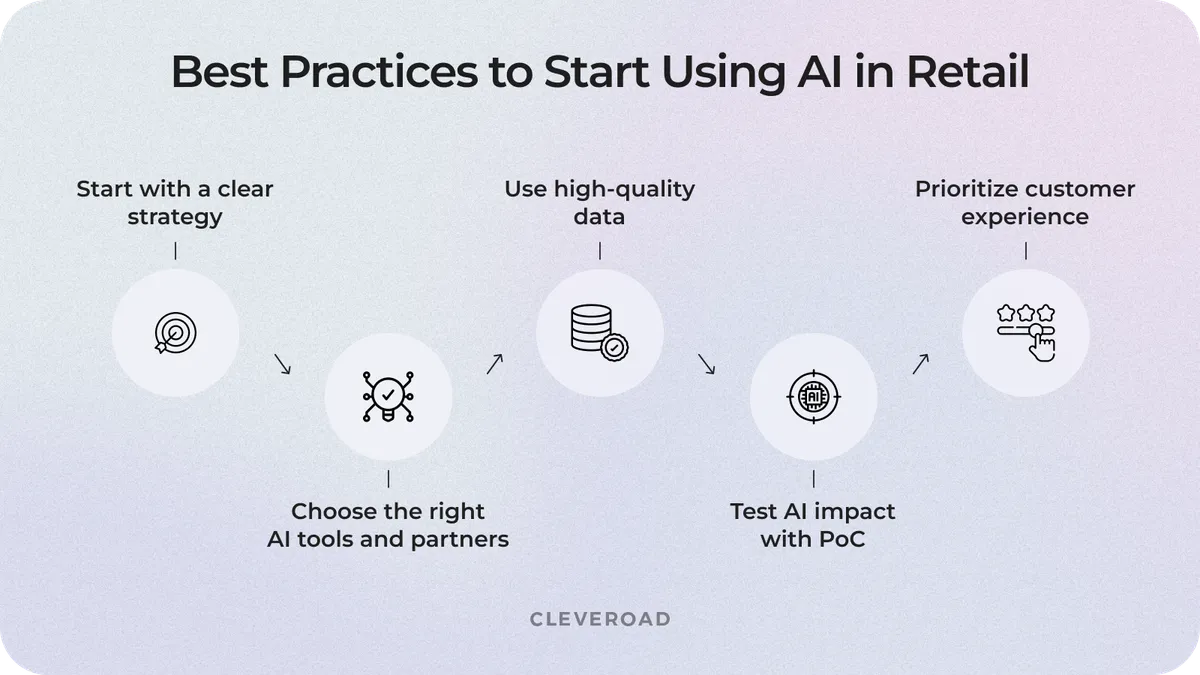
Best practices to start using AI in retail
Start with a clear strategy
Before investing in AI in retail, companies must define what business value they expect from it. Instead of treating AI as a trend, outline specific objectives: improving customer experience, optimizing pricing, increasing sales, or making operations more efficient. A clear strategy helps align data and teams toward measurable outcomes.
Start by identifying a few high-impact areas where artificial intelligence in retail can quickly prove its value, such as demand forecasting or personalized marketing. Then, determine what data and processes you need to support those initiatives. Also, establish key metrics for success, including customer satisfaction or cost reduction, and use them to guide decision-making as you scale.
Explore our custom AI advisor to discover the most effective ways to apply AI in retail and address your specific business challenges with tailored, data-driven solutions
Choose the right AI implementation partner
To integrate AI as quickly and easily as possible, you need a reliable technical partner. When evaluating potential partners, focus on their experience in retail app development, AI solutions implementation, technical expertise, and ability to customize tools to your business needs. A reliable partner helps you choose scalable and compliant technologies, ensures smooth integration, and provides ongoing model maintenance. Such an approach reduces risks and ensures your artificial intelligence in retail initiatives delivers measurable results.
Cleveroad has practical experience in providing retail and marketplace products. Our client from London turned to us to develop a mobile app that could attract new customers to local bars and pubs while helping venues boost engagement through personalized offers, a platform named El Tab.
Our team developed a Flutter-based cross-platform app with integrated payment systems and smart notifications that analyze user activity to deliver relevant bar suggestions at the right time. We also built a web-based admin dashboard to manage users, partners, and promotions efficiently.
As a result, El Tab launched a stable, user-friendly mobile solution that increased partner visibility, improved customer retention, and strengthened engagement through AI-powered personalization and timely push notifications.
Here is what Oliver Carew, Founder of El Tab, says about collaboration with Cleveroad:
Oliver Carew, Founder of El Tab. Feedback about cooperation with Cleveroad
Use high-quality data
The success of AI in retail depends on the quality of your data. Clean, structured, and reliable information ensures accurate insights and predictions. That’s why your technology partner should take full responsibility for preparing, validating, and maintaining data pipelines.
A trusted AI vendor helps you collect and organize information from all key sources, such as POS systems, CRM, eCommerce, or IoT devices, and ensures that it’s accurate, secure, and consistent. They set up automated validation, remove duplicates, and prepare data features used for recommendations, pricing, and forecasting. With professional support, your AI retail solutions start with the right data foundation, which directly translates into better performance and faster results.
Test AI impact with PoC
Before scaling, it’s smart to test your idea through a Proof of Concept (PoC). A skilled vendor will help design and run this test using your real data to evaluate how AI retail analytics performs under real business conditions. Together, you define measurable goals, for example, higher conversion rates or more accurate demand forecasts. Then develop and implement the PoC, monitor key performance indicators, and adjust the model or approach based on real-world performance to ensure continuous improvement and scalability.
Once the PoC shows positive results, your partner helps integrate the tested solution into production, automate retraining, and scale it across all retail systems. This step-by-step approach ensures quick ROI and minimizes implementation risks for your artificial intelligence in retail initiative.
Test your idea with our AI PoC services! We will help you define if your future AI solution brings real business value
Prioritize customer experience
Every AI initiative should ultimately improve the shopping journey. The vendor you choose must design AI technology in retail around customer outcomes, including faster service, smarter recommendations, and more personalized communication.
A reliable partner ensures that your chatbots, pricing engines, and recommendation systems work safely, respond quickly, and deliver value to both the business and the customer. They also monitor the models, prevent bias, and maintain transparency, ensuring that your AI in shopping and AI in stores enhance trust and loyalty rather than compromise it.
Cleveroad's Expertise in Retail and Artificial Intelligence
Cleveroad is a skilled software development vendor with deep retail and eCommerce domain expertise and solid AI technology knowledge. Our team delivers end-to-end retail automation services, including AI consulting, PoC development, scaling and implementation, custom software development, legacy system modernisation, UI/UX design, third-party services integration, and more. For over 15 years, we’ve been helping startups, mid-sized companies, and large enterprises enhance their retail operations through AI-driven innovation and scalable, results-focused solutions.
Choosing Cleveroad for AI implementation, you’ll get:
- AI Strategy Workshops that help you identify the most valuable AI in retail use cases and create a clear roadmap from idea to implementation
- Proven expertise in integrating retail platforms with third-party tools such as Shopify, Salesforce, QuickBooks, Stripe, and HubSpot, enabling seamless workflows and unified business operations.
- Cloud and AI adoption support as an AWS Select Tier Partner, with Amazon Bedrock, SageMaker, and AWS Glue to accelerate retail AI initiatives
- AI Proof-of-Concept development to validate the relevance and performance of retail AI solutions in your existing IT environment before scaling
- ISO-certified processes with ISO 9001 for quality management and ISO 27001 for information security, ensuring compliance and trust at every stage of the project
Cleveroad helps retail and eCommerce companies build scalable digital platforms that optimize customer journeys, integrate secure payment systems, and simplify product management, all while ensuring fast deployment and an intuitive user experience.
One of our recent success stories in the retail domain is a B2C Marketplace Platform developed for a U.S.-based entrepreneur. Our client needed to create a comprehensive marketplace connecting sellers and individual buyers through both a mobile app and a web dashboard.
We developed a platform that includes essential eCommerce components such as a catalog and product management, integrated payment gateways, flexible delivery settings, and advanced admin panels for efficient order and user management. To deliver a modern and reliable architecture, we used React.js, Node.js, and AWS cloud infrastructure, ensuring secure data processing, seamless scalability, and stable performance under heavy workloads.
The solution’s modular, API-driven design also enables future integration of AI capabilities, including intelligent search, dynamic pricing, and personalized product recommendations, providing long-term adaptability for the client’s growing business.
Also, one of our notable retail projects is RetailOps, a SaaS retail operations platform we've created for a US-based company providing digital solutions for commerce businesses.
Our client needed a single solution to manage warehouses, inventory, and receiving operations efficiently, something existing tools couldn’t provide. They partnered with Cleveroad to rebuild their legacy system from the ground up, transforming it into a scalable, high-performance platform with a modern, user-friendly design.
We delivered a native iOS app built in Swift that connects all retail back-office operations in one place. The platform supports real-time inventory tracking, barcode scanning, and warehouse process automation, while integrating seamlessly with external hardware like portable data terminals.
As a result, RetailOps gained a unified retail operations platform that streamlines warehouse workflows, optimizes order management, and enhances overall operational efficiency.


Implement AI innovation into your retail business
Cleveroad AI specialists are ready to help you integrate cutting-edge technologies to design and implement AI solutions for your retail organization that boost efficiency and customer engagement
Artificial intelligence (AI) is a broad term that refers to computer systems capable of performing tasks that typically require human intelligence. When applied to retail, AI systems can analyze enormous volumes of information, such as sales transactions and customer profiles, or sensor data and market trends. AI analyzes this information to predict demand and improve every stage of the value chain.
AI is changing the retail sector by enabling data-driven decisions, automating operations, and personalizing customer experiences at scale. It helps retailers predict demand, optimize inventory, and deliver smarter pricing and marketing strategies. As a result, retail executives make their businesses more efficient, agile, and customer-focused.
The best use cases and examples of AI in retail are:
- Personalized customer experience
- Improved cross-selling opportunities
- Automated inventory management
- Demand forecasting
- Frictionless shopping
- Optimized pricing
- Dynamic merchandising
- In-store robots
- Smart stores
- Supply chain optimization
AI can help retail businesses operate more efficiently and create personalized shopping experiences for every customer. Retailers can use AI to analyze the market and support smarter pricing and inventory management. So, AI can help retailers increase customer satisfaction and strengthen business performance.
Despite its benefits, AI can also bring challenges you need to overcome. They include poor data quality and integration with legacy systems. Many retailers also face high implementation costs and difficulties scaling AI across operations. Overcoming these barriers requires strong data management, skilled partners, and a clear adoption strategy.

Evgeniy Altynpara is a CTO and member of the Forbes Councils’ community of tech professionals. He is an expert in software development and technological entrepreneurship and has 10+years of experience in digital transformation consulting in Healthcare, FinTech, Supply Chain and Logistics
Give us your impressions about this article
Give us your impressions about this article
